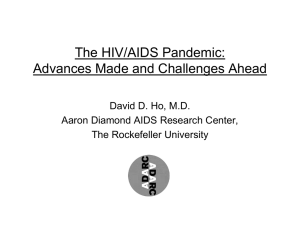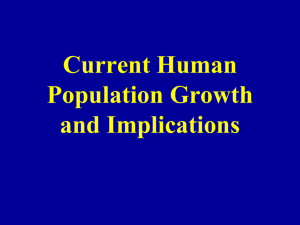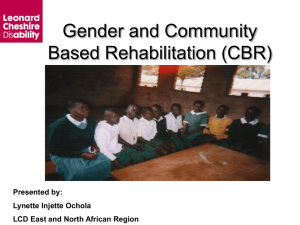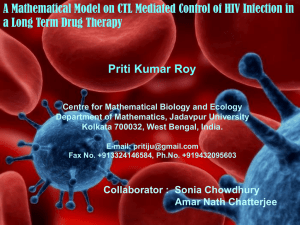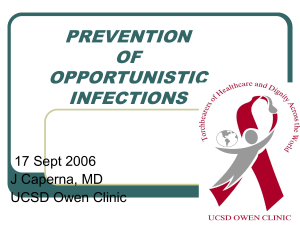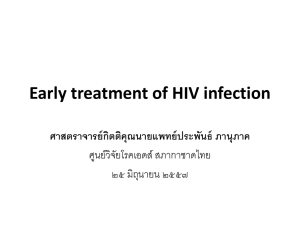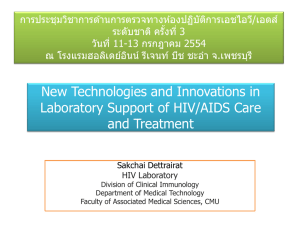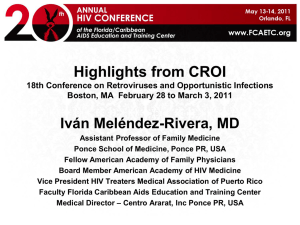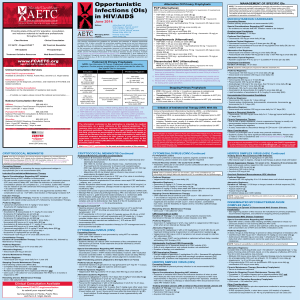Opportunistic Infections in HIV
advertisement
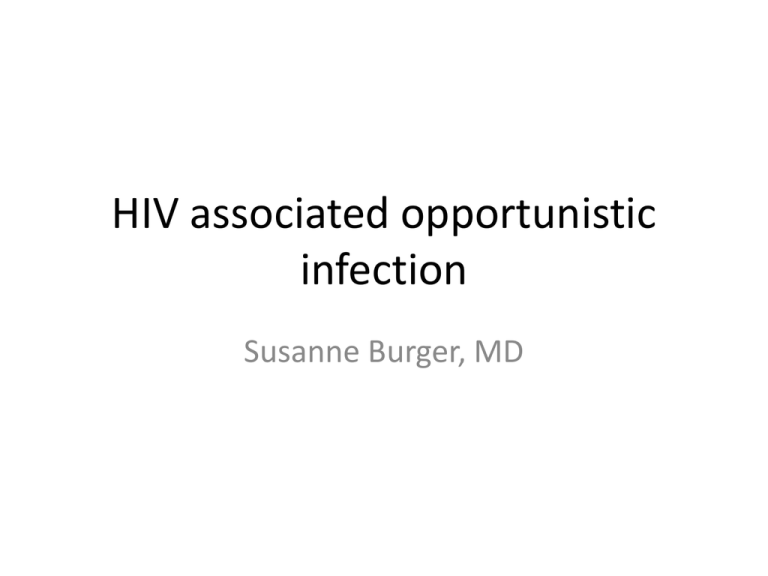
HIV associated opportunistic infection Susanne Burger, MD Impact of HAART on the Incidence of Opportunistic Infections PCP MAC CMV Retinitis Toxoplasmosis HAART Typical Relationship of Clinical Manifestations to CD4 Count in HIV Infected Patients Lymphoma Tuberculosis Kaposi Sarcoma Herpes Zoster 50 Criteria for Starting, Discontinuing, and Restarting Opportunistic Infection Prophylaxis for Adults with HIV Criteria for Initiating Primary Prophylaxis Criteria for Discontinuing Primary Prophylaxis Criteria for Restarting Primary Prophylaxis Criteria for Initiating Secondary Prophylaxis Criteria for Discontinuing Secondary Prophylaxis Criteria for Restarting Secondary Prophylaxis PCP CD4 < 200 or oral candidasis CD4 > 200 for 3 mos CD4 < 200 Prior PCP CD4 > 200 for 3 mos CD4 < 200 Toxoplasmosis + serum IgG CD4 < 100 CD4 > 200 for 3 mos CD4 < 100 – 200 Prior toxoplasmic encephalitis CD4 > 200 sustained and completed initial therapy and is asymptomatic CD4 < 200 MAC CD4 < 50 CD4 > 100 for 3 mos CD < 50 – 100 Documented disseminated disease CD4 > 100 sustained and completed 12 mos of MAC tx and asymptomatic CD4 < 100 Cryptococcosis none n/a n/a Documented disease CD4 > 100 – 200 sustained and completed initial therapy and asymptomatic CD4 < 100 200 Histoplasmosis none n/a n/a Documented disease No criteria recommended for stopping n/a CMV none n/a n/a Documented end-organ disease CD4 > 100 – 150 sustained and no evidence of active disease and regular exams CD4 < 100 150 OI Approach to Respiratory Disease in HIV Infection: Diagnostic Clues Parameter Example Rapidity of onset > 3 days: PCP, Tb < 3 days: bacteria Temperature Afebrile: neoplasm Character of sputum Purulent: bacteria Scant: PCP, Tb, virus Laboratory Tests WBC, LDH ↓O2 post exercise X-ray atypical Pattern: Beware! Isolation? Pneumocystis Jiroveci (Formerly P. carinii) • Taxonomy – Fungus vs. Protozoan • Epidemology – Environmental source unknown • Life Cycle – Unknown • Transmission – Respiratory • Well documented in rodents • Presumptive in man Diagnosis of Pneumocystis Pneumonia A 30 year-old male with HIV infection and fever, cough, and diffuse infiltrates has a bronchoscopy performed. Which of the following is the most sensitive and specific test to perform to establish whether or not pneumocystis is the causative pathogen? a. PCR of the bronchalveolar lavage (BAL) b. Culture of the BAL c. Immunoflourescent stain of the BAL d. ELISA of the BAL e. Serum PCR A patient with HIV infection presents with PCP (room air pO2=82mHg). He has a history of a severe exfoliative rash to TMP-SMX. Which of the following therapies would you recommend: a. TMP-SMX + Prednisone b.TMP + Dapsone c. Parenteral Pentamidine d.Clindamycin plus pyremethamine e.Atovaquone A 50 year-old male with HIV and PCP is receiving pentamidine 4mg/kg IV over 1 hr qd. On the ninth day of therapy, while awaiting transportation home, he has a syncopal episode. What is this rhythm? Toxicity Regarding Antipneumocystis Therapy Drug Issues TMP-SMX Toxicities: ↓WBC, ↓Plat, ↑LFT ↑Creat, ↑Amylase, rash, fever Cross reactivity: dapsone (+/- 50%) Pentamidine Hypotension, ↑Crea, ↑Amylase, ↓WBC ↓Glucose: related to ↑Crea occurs days-wks post-rx Torsade de Pointes Atovaquone Absorption Clindamycin + Primaquin Rash, LFT, diarrhea Methemoglobinemia Hemolytic anemia (G-6-PD) Dapsone Rash, fever, ↑LFT, Hemolytic anemia (G-6PD), peripheral neuropathy 22 y/o patient with CD4 = 69 and bilateral interstitial infiltrates on CXR has been started on treatment with iv bactrim for presumptive PCP. On day #3 he still c/o dyspnea and reports that his symptoms have not improved since admission to the hospital. What do you do? Management of Patients with AIDS Related PCP Who are Failing TMP-SMP • Add corticosteroids (if not already done) • Switch to alternative treatment • Reassess diagnosis – Is PCP correct? – Are there any other pathogens? • Is aggressive/longer term support appropriate? – Patient wishes – Realistic assessment of prognosis A 34 y/o man who has been HIV pos for ~ 10 years is brought to the ER after a witnessed seizure. He had been receiving HAART until ~ 5 years ago when he dropped out of care. Family members report that he has had some memory loss and unusual behavior for the past 2 weeks. On PE is he is confused and disoriented. Evaluation of CNS Mass Lesions in Patients with AIDS Toxoplasmosis Lymphoma PML Tuberculosis Fungus Nocardia Bacterial Syphilis Kaposi Sarcoma Glioblastoma Radiologic non specific extra CNS lesions Laboratory Serology – Toxo IgG, crypt Ag Blood culture – AFB, fungus CSF – Crypt Ag, CMV PCR, EBV PCR Urine – Histo Ag Empiric Therapy How is toxoplasmosis most often transmitted in the United States? Clinical Manifestation of Toxoplasmosis when Acquired Post-Partum Acute infection Asymptomatic Lymphadenopathic Specific Organ Dysfunction (80 – 95%) (5-10%) (Rare) Chronic Latent Infection Abnormal Immunity Normal Immunity (HIV, Hodgkin’s, etc) Asymptomatic Retinochorioditis (Most) (Few) Cerebral Disseminated Toxoplasmosis - Diagnosis • Definite diagnosis: Biopsy with demonstration of tachyzoites • Presumptive diagnosis acceptable when – CD4 < 200 – Compatible neurologic disease – No prophylaxis – Serology: positive toxo IgG Therapy for Cerebral Toxoplasmosis • Preferred Regimen – Sulfadiazine + pyremethamine • Alternative Regimen – Clindamycin + pyremethamine • Less studied regimens – TMP-SMX – Atovaquone + sulfadiazine – Azithromycin + pyremethamine – Dapsone + pyremethamine A 35 year-old male with HIV (CD4 = 30, VL 100k copies) not on HAART, is brought to the emergency room with several weeks of declining cognitive function, ataxia, and aphasia. CT scan shows multiple hypodense, non enhancing cerebral white matter lesions. The gray matter is spared. CSF analysis shows: WBC 25 (100% lymphs), protein 110 mg/dl; glucose 90 mg/dl; VDRL neg, Crypt Ag neg, PCR for JC virus positive What therapy is effective for this condition: a. high dose acyclovir b. Cidofovir c. Vidarabine d. Foscarnet e. None of the above Infectious Non-focal Brain Disease Clinical Features Lesion Type Temporal Progression Level of Alertness Fever PML Weeks Preserved Absent AIDS dementia complex Weeks/months Preserved Absent CMV encephalitis Days/weeks Reduced Common HIV associated CMV Disease Pre-HAART, 30% of patients developed: – Retinitis – Colitis – Others: • • • • • Pneumonitis Ventriculoencephalitis Myelitis Radiculomyelopathy Adrenalitis Diagnosis of CMV Disease • Serology (IgG, IgM) • Viremia common in asymptomatic persons with low CD4 • Histology required for diagnosis of colitis and pneumonitis • ‘owl’s eye ‘ intranuclear inclusion bodies pathognomonic • Rare cells in the absence of clinical disease insignificant • Retinitis clinical diagnoses • Fluffy exudate • CNS – CMV PCR CMV Detection in Specific Anatomic Sites Site Significance BAL None Blood (cells, plasma) maybe CSF Qualitative: probably Mycobacterium Avium Intracellulare Complex • Epidemiology: Ubiquitous in dirt, animals etc • Avium: 95% isolates • Transmission – Respiratory and GI, environmental source undetermined – Person-to-person NOT likely • Clinical manifestations – Fever, wasting, ↑nodes, ↑liver, ↑spleen – Rare as cause of lung disease – Labs: ↑alk pho, ↓Hb (severe), ↓albumin Mycobacterium Avium Intracellulare: Diagnosis and Treatment Compatible clinical syndrome + Isolation of M. avium • Source of Isolates – Blood (if patient symptomatic) Pos culture 80 – 90 %: Bactec (7-14 days), solid (21 days) – Sputum/Stool/Urine • Low predictive value • Treatment: Clarithro (or Azithro) + Ethambutol (+/- Rifabutin) x 1 year Show and Tell Cryptococcal Meningitis in Patients with HIV Infection • Epidemiology: CD4 count < 50 cells/mm3 (75% cases) • Diagnosis – CSF: Ag positive 95-100% – Serum: CRAG positive 95-99%, – Blood Culture: positive 75% • Poor prognosis – Abnormal mental status – Low CSF WBC • Beware unusual presentations – Skin (molluscum) – Lung (variable x-ray) – Screening with CRAG: Titer > 1:8 should be treated Therapy of Cryptococcal Meningitis Amphotericine B 0.7 mg/kg qd +/Flucytosine 25mg/kg qd • 2 weeks +/Daily LP if CSF pressure elevated Fluconazole 400 • 8 weeks mg po Fluconazole 200 • > 14 weeks mg po Increased Intracranial Pressure (ICP) Association of Mortality with Baseline CSF Opening Pressure Opening Pressure <190 – 249 mm n = 102 250 – 349 mm n = 59 > 350 mm n = 60 # (%) of Deaths 21 (21%) 16 (27%) 23 (38%) Median mos. To death 10.5 7 6◊ ◊ Pts with the highest baseline Ops (>250) also had higher titers CRAG and more frequent H/A, meningismus, papilledema, hearing loss and pathologic reflexes Graybill et al. Clin Infect Dis. 2000;30:47 Management of increased ICP • For pts with ICP > 250 mm H2O perform daily or qod LPs. Remove CSF volume up to 30 cc to reduce OP to 50% of the baseline OP. • Placement of lumbar drain and option, but infections and drain malfunction are major concerns. • Ventriculostomy catheter to drain and monitor ICP. High risk for infection. • Ventriculoperitoneal (internalized) shunt in pts with or without evidence of hydrocephalus. Risks include potential infection, dissemination of cryptococcus, and shunt obstruction. Serial Crypt Antigen Titers • Serum – Changes do NOT correlate with therapeutic response • CSF – Changes are helpful but repeated LPs not necessary if patient is responding well clinically • Note: – Some clinicians advocate LP with culture and Ag before stopping maintenance: controversial



